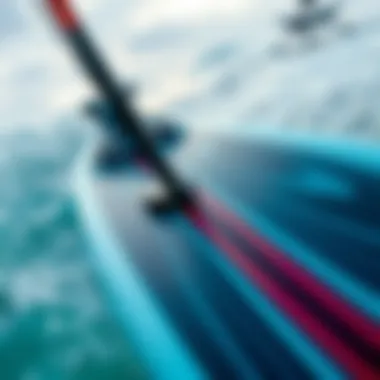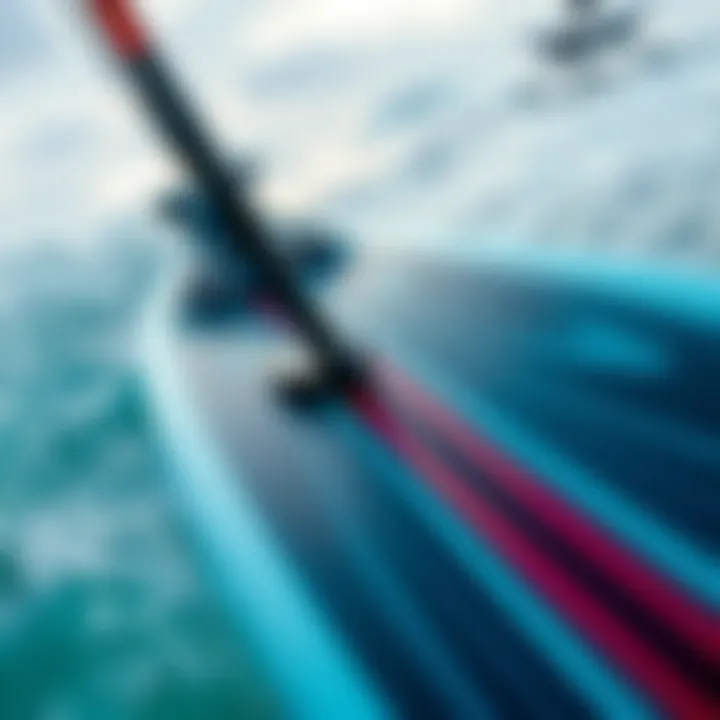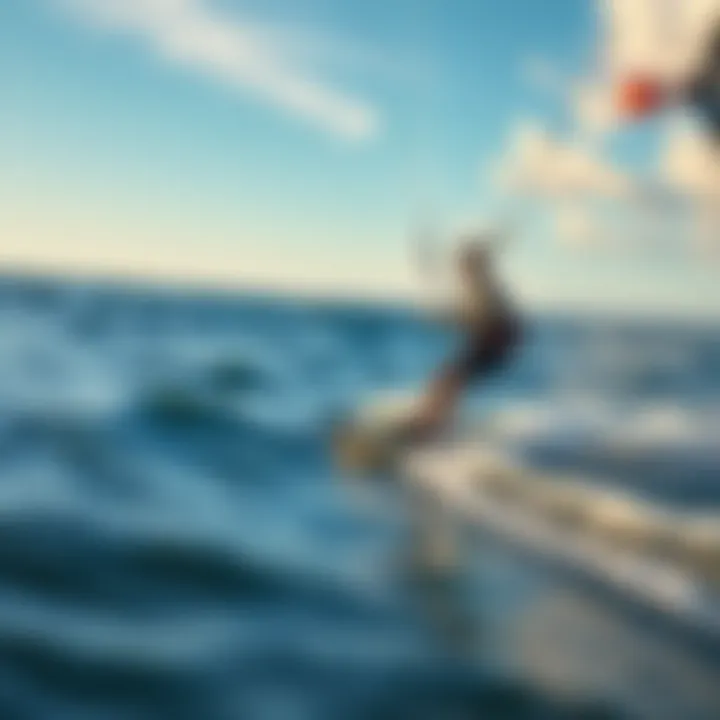Understanding Hydrofoil Surfboards: A Motor-Free Journey


Intro
Hydrofoil surfboards represent a fascinating leap in water sports technology that captures the imagination of both enthusiasts and beginners alike. Unlike traditional surfboards that remain in contact with the water, hydrofoil boards allow riders to glide above the surface. This concept not only transforms the kitesurfing experience but also presents a range of unique challenges and benefits. In this article, we will explore the mechanics of hydrofoil surfboards, the crucial gear needed for kiteboarding, and safety practices essential for anyone looking to master this exhilarating sport.
As eco-awareness grows within the recreational community, the rise of motor-free hydrofoil boards highlights a commitment to sustainability. Riding on the waves without the throaty roar of engines is an appealing concept for many adventure seekers. Additionally, as we delve into these boards' structure and performance, it’s important to highlight what draws kiteboarders to embrace them. By doing so, our conversation takes a deep dive into not just the how-tos but also the why behind the increasing popularity of hydrofoiling.
Let’s begin our exploration by discussing the necessary gear and equipment that every kiteboarding enthusiast should consider.
Understanding Hydrofoil Surfboards
Hydrofoil surfboards have come into their own in recent years. This technological marvel has attracted the attention of adventure seekers who relish the idea of gliding above water without a motor. Understanding how hydrofoils work and their design is key for surfers looking for a new challenge. Hydrofoiling offers an experience that is both thrilling and serene, making it popular among enthusiasts.
The importance of grasping the principles behind hydrofoil surfboards lies in their unique characteristics and advantages compared to traditional surfing. Riders enjoy a sensation akin to flying over water, facilitated by the hydrofoil's ability to lift the board above the surface. This not only reduces drag but also provides a smooth ride over any water conditions. Additionally, understanding these boards can enhance a rider’s skill set, enabling them to perform maneuvers that seem almost magical.
Basic Principles of Hydrofoiling
At its core, hydrofoiling is a simple yet incredible physics phenomenon. The hydrofoil consists of wings that generate lift as they move through the water. This allows the board to rise above the surface, where friction is minimized. The sensation of harnessing the power of the wind and waves in this manner is what draws many thrill-seekers and water sports lovers to hydrofoil surfing.
When a force is applied, typically from paddling or the motion of the waves, those wings create an upward thrust that elevates the rider. Adjustments in weight and balance can influence how high the board flies, making it a game of finesse and technique.
Key Components of a Hydrofoil Surfboard
Understanding the structure of hydrofoil surfboards is crucial for anyone looking to delve into this sport.
Foil Lift
The Foil Lift is arguably the most significant element of hydrofoil surfboards. This aspect relates to how effectively a hydrofoil generates upward thrust. The shape of the foil and the angle at which it enters the water determine its efficiency. A well-designed foil can provide lift at lower speeds, which is ideal for beginners who might struggle with speed control.
The key characteristic of foil lift is its efficiency. By crafting foils that optimize lift-to-drag ratios, manufacturers can significantly enhance the surfing experience. A major reason why this is a beneficial option is that it facilitates smoother rides, even in choppy waters, which would typically hamper traditional boards. However, care must be given to the design of the foil, as those with too aggressive angles can lead to instability and undesirable nosedives.
Board Design
Board Design plays a vital role in how the hydrofoil functions. The overall shape, including length, width, and thickness, affects buoyancy and maneuverability. A longer board might offer more stability, while a shorter one could allow for sharper turns. Riders must consider their skill level when choosing a board; beginners might prefer a more stable and wider design, whereas seasoned riders could opt for boards that offer heightened agility.
An outstanding feature of hydrofoil surfboard designs is their versatility. Many boards now come equipped with mount options for different foils or fins, allowing customization based on the rider's preferences. This adaptability is one of the advantages that riders appreciate the most, as it encourages personalization based on individual skill and style.
Fins and Stability
Fins and stability are essential when discussing hydrofoil surfboards. Fins serve to aid with directional control. They help prevent slipping and allow for better maneuverability when turning. The stability provided by fins is critical because, without them, riders risk losing control during their hydrofoil experience.
A notable characteristic of fins used on these boards is their design and placement. Some riders favor more significant or multiple fins for added stability, while others may choose smaller designs for increased speed and fluidity. Ultimately, the choice of fins can impact the overall experience and is a consideration riders need to think about carefully.
"In hydrofoil surfing, every detail counts. The right combination of foil, board, and fins means the difference between a smooth glide and a rough tumble."
Finale
Hydrofoil surfboards merge technology with a profound sense of adventure. By understanding how each component interacts, riders can make informed choices that cater to their style, skill level, and desired experiences on the water. With such insight, enthusiasts can fully embrace what the world of hydrofoiling has to offer.
Motor-Free Hydrofoiling: An Overview


Motor-free hydrofoiling has emerged as a fresh frontier in water sports, catching the attention of adventurers and enthusiasts alike. This approach eliminates the need for gas or electric propulsion, leading to an experience where the rider becomes one with nature. Picture gliding over the surface, the sound of a whispering wind and waves accompanying each movement. It’s not just about the thrill but also about how seamlessly one can interact with the environment. This practice highlights balance, technique, and an understanding of hydrodynamics, making it a uniquely engaging pursuit.
The Concept of Motor-Free Operation
Motor-free hydrofoiling is built on the idea that one can harness natural forces for propulsion. Riders use a select set of techniques, relying on the wind, swells, and their own physical strength. By learning the art of timing and manipulating the board, individuals can achieve impressive lifts and speeds. This aspect emphasizes skill over machinery; it's a return to basics, attracting those who yearn for a more authentic connection with their sport. The resulting experience becomes not only about carving through waves but also about mastering a dialogue with the ocean.
Advantages of Going Motor-Free
Enhanced Control
One of the most significant elements of motor-free hydrofoiling is the enhanced control it offers the rider. Without a motor's constant push, each moment on the board becomes fully customizable. Riders can adjust their stance, utilizing shifts in weight to determine speed and direction at will. This allows for finer manipulation of the board, letting folks adapt quickly to changing water conditions. The ability to dictate one's movements makes it especially appealing to those who appreciate the nuances of water dynamics. The control gained here is something that motorized approaches often lack, where speed can overshadow mastery.
Reduced Environmental Impact
The growing emphasis on sustainability cannot be understated. By discarding motors, hydrofoiling becomes significantly more environmentally friendly. Less noise pollution and zero fuel emissions mean a gentler impact on marine ecosystems. This makes hydrofoiling not just an exhilarating experience but also a responsible choice for adventure seekers who wish to leave the world as they found it. This reduced environmental impact is becoming part of the ethos of many outdoor sports communities today. It provides a simple yet effective way to enjoy nature while respecting it.
Lower Maintenance Requirements
Another appealing aspect is the lower maintenance requirements associated with motor-free hydrofoils. Traditional motorized boards can be a hassle: fuel, complex mechanics, and maintenance can be burdensome. In comparison, hydrofoils are simpler and more straightforward. With fewer mechanical parts subject to wear and tear, riders often find that their equipment lasts longer with less fuss. This ease of upkeep not only saves money but also eliminates many barriers for new riders looking to join the fold. The uncomplicated nature of these boards contributes to greater accessibility, making it an attractive option for newcomers and veterans alike.
"Hydrofoiling without a motor connects riders to the wave, the wind, and their own skills like never before." - Hydrofoil Enthusiast
In summary, motor-free hydrofoiling embodies a thrilling and environmentally conscious approach to water sports. Riders gain access to unparalleled control, foster a love for sustainability, and enjoy lower maintenance hurdles. As the popularity of this practice continues to grow, so does the sense of community and camaraderie among those who pursue it.
Navigating Safety and Risk
Understanding safety and risk management while hydrofoiling is not just a matter of precaution; it is essential for enjoying the sport fully and sustainably. Hydrofoil surfboards offer an exhilarating experience, but they also come with inherent risks that every rider needs to be aware of. Knowledge and preparedness can not only enhance your enjoyment but also significantly reduce the chances of accidents.
Common Risks Associated with Hydrofoiling
Falling Techniques
Falling is a natural part of mastering hydrofoiling. Like other sports, taking a tumble can be part of the learning curve. However, understanding how to fall effectively can mitigate injuries. Practicing safe falling techniques allows riders to roll away from their boards instead of landing flat and stiff. This method is beneficial because it helps distribute the impact forces more evenly across the body. Imagine being able to avoid that painful slap of water or, worse, landing awkwardly on the board itself.
A key characteristic of effective falling techniques lies in flexibility. The idea is not to resist the fall but to adapt to it. For instance, bending your knees as you fall can absorb some of the impact, lessening the risk of injury. Unique to hydrofoiling, this technique provides an opportunity to learn from falls. Many riders emphasize practicing falling in calmer waters to build confidence and reflexes. The main disadvantage? Some may find it challenging to let go of their fear of falling, which could hinder skill acquisition.
Collisions and Injuries
Collisions represent another significant risk factor in hydrofoiling. Whether you are riding solo or in a crowd, the potential for unexpected collisions with other surfers, boats, or obstacles is always present. This risk underscores the importance of awareness and distance management while navigating waters. Understanding your surroundings allows you to enjoy the ride without constantly worrying about unforeseen obstacles.
A defining feature of collision-related injuries often comes from the speed and momentum involved. An oncoming paddleboard or jet ski could lead to serious accidents if a rider is unaware. To counter these risks, learning the right etiquette and communication signals with other water users is crucial. The advantages of familiarizing yourself with traffic patterns and respecting fellow riders are clear; it not only fosters a safe environment but provides an immense boost to confidence as well. Conversely, getting complacent could lead to dire consequences.
Essential Safety Gear
Safety gear is indispensable in protecting riders from the unique hazards associated with hydrofoiling. It's always wise to gear up before hitting the water. The right equipment not only promotes safety but also enhances the overall experience.
Helmets
Helmets are perhaps the most critical piece of safety gear for hydrofoil riders. Though some may perceive them as an inconvenience, helmets effectively protect against head injuries from falls or collisions. A quality helmet designed for water sports can specifically absorb impacts on the water's surface, providing better protection than traditional bike or skate helmets.


A vital characteristic of helmets is their streamlined designs paired with ventilation features to ensure rider comfort. They also come in various styles and colors, allowing some personal expression while prioritizing safety. One drawback is that some riders may feel restricted or hot, especially in warmer conditions. However, the trade-off of safety far outweighs the comfort issues.
Impact Vests
Impact vests are another necessary layer of safety equipment. Acting as a buffer against sudden impacts, they shield your torso from accidental collisions and rough landings. These vests are designed to float, offering buoyance in case of an unexpected fall.
A defining feature of impact vests is their lightweight construction, ensuring a snug fit without compromising mobility. Many riders appreciate the fashion-forward designs that align with their style. However, they should never replace a life jacket or buoyancy aid; understanding their intended use is vital.
Wetsuits
Wetsuits might not directly contribute to preventing injuries but play a significant role in thermal protection during colder water sessions. They provide insulation while ensuring flexibility during movements. For those who hydrofoil in brisk waters, a suitable wetsuit becomes a necessity rather than an option.
Wetsuits are available in various thicknesses and styles, enabling riders to select a product that best suits their needs. It's also worth noting that they protect the skin from scrapes and sunburn, making them invaluable gear. However, the common downside includes restricted movement if improperly fitted. Finding the right balance is key to enjoying your hydrofoiling experience fully.
Harness the power of knowledge when engaging in hydrofoiling; it helps create a safer and more enjoyable experience for everyone involved.
Technique and Skill Development
Hydrofoiling isn't just about having the right equipment; it’s an intricate dance between skill and technique. Understanding the nuances of hydrofoil surfing grants enthusiasts the ability to harness the ocean's power more effectively. On the surface, it may appear as if you’re simply gliding over water, but the reality is layered with challenges and triumphs that—once mastered—transform a novice into a proficient rider.
The significance of developing technique lies in the critical balance between control and freedom. Each movement on a hydrofoil surfboard reverberates through the structure, influencing everything from speed to stability. As kiteboarders venture into this specialized sport, honing their abilities not only heightens the enjoyment but also decreases potential risks. Recognizing that each skill, from body positioning to mastering tricks, contributes directly to a rider’s overall experience is vital.
Learning to Hydrofoil
Starting the journey into hydrofoiling can feel overwhelming. However, understanding the foundational skills is crucial. Learning to hydrofoil begins with understanding how the hydrofoil works and how to position oneself appropriately on the board. This involves a steep learning curve, but each practice session helps engrain essential skills. Newcomers should focus not just on getting up but on maintaining control as they progress, which requires both patience and perseverance. The thrill of breaking through the water surface for the first time is a reward that often outweighs the struggles.
Progressing from Beginner to Intermediate
Stance and Balance
Stance and balance represent the bedrock of successful hydrofoiling. An incorrect stance can cause instability and hinder progress. The key characteristic of an effective stance lies in alignment; having feet shoulder-width apart ensures that the weight distribution is ideal.
An appropriate stance provides a sturdy platform, facilitating smoother transitions and ensuring better control of the surfboard. With balance being crucial, a hydrofoiler learns to make micro-adjustments that might seem trivial yet can dramatically influence performance. Focusing on this element can mean the difference between riding the gentle swells or stumbling back into the water.
Controlling Speed and Lift
Controlling speed and lift is an essential aspect when it comes to mastering hydrofoiling. Riders must learn to adjust their weight to find that sweet spot where lift is maximized without compromising stability. The unique feature of hydrofoiling is how a small shift in weight alters lift and speed.
Increasing lift can elevate the rider above the waves, while losing control can lead to rapid descents back into the water. Herein lies a challenge—balancing speed with the right lift becomes a dance of fluidity. Knowing when to accelerate and when to ease off is a skill developed over time and practice.
Advanced Hydrofoil Techniques
Jumps and Tricks
As riders become more comfortable on their hydrofoil surfboards, they often crave the adrenaline rush that comes from executing jumps and tricks. The appeal of these advanced moves rests in their display of both creativity and skill. The essential characteristic of jumps is timing; understanding when to initiate a jump creates the momentum necessary for success.
Jumps not only add an exciting dimension to the sport but also bolster confidence. When mastered, riders can incorporate a variety of tricks to showcase their proficiency. However, the practice involved in perfecting these tricks can lead to unexpected falls, making patience essential.
Turning Techniques


Turning is another critical skill that adds depth to a rider's experience. Effective turning techniques involve planning and timing, which can be challenging to sync, especially for beginners. The characteristic of a good turn lies in smooth execution—too abrupt a movement can lead to instability.
However, mastering turning can significantly enhance maneuverability on the water. Riders can navigate tight spots, dodge obstacles, and even perform impressive turns that catch the eye. Austin Campbell, a veteran in the hydrofoiling community, said it best: "The magic happens when you’re comfortable enough to turn without hesitation, weaving through waves like they don't even exist."
Environmental Considerations
As the world increasingly confronts climate change and environmental degradation, the concept of environmentally friendly sports and activities gains prominence. Hydrofoil surfing, in particular, stands out as a thrilling endeavor that carries significant environmental considerations worth exploring. The focus on motor-free hydrofoiling not only caters to the spirit of adventure but also aligns with a growing eco-conscious mindset. This section sheds light on the environmental benefits of hydrofoiling, along with sustainable practices enthusiasts can adopt to further minimize their ecological footprint.
Environmental Benefits of Hydrofoiling
Hydrofoiling offers a host of environmental advantages when juxtaposed against more conventional water sports that can involve motorized equipment. Here are some key benefits:
- Reduced Fuel Consumption: Motorized water sports often rely on gasoline or diesel, which contribute to water pollution and greenhouse gas emissions. Hydrofoil surfboards, operating without motors, eliminate this concern altogether.
- Less Noise Pollution: The absence of an engine means a quieter experience on the water, providing a more serene interface with nature. This reduction in noise pollution also benefits marine life, whose habitats can be altered by the sounds of engines.
- Minimal Impact on Marine Ecosystems: Unlike motorized vessels, hydrofoils glide above the water. This means less chance of disturbing aquatic habitats or harming fish and other wildlife below.
- Encourages Eco-friendly Mindsets: Engaging in an environmentally friendly sport can foster a deeper appreciation of nature. This, in turn, may encourage advocates for conservation and sustainable initiatives within the community.
"Embracing hydrofoiling means not just enjoying the rush but also taking action to preserve our precious ecosystems."
Sustainable Practices for Hydrofoil Enthusiasts
While hydrofoiling is inherently more sustainable, the community can enhance environmental stewardship by adopting certain practices:
- Opt for Eco-friendly Materials: Many surfboard manufacturers are beginning to explore sustainable materials like recycled foam and bio-resins. By choosing boards made from these materials, enthusiasts can make a minimal environmental footprint while enjoying their sport.
- Commit to Clean-Up Efforts: Participating in or organizing beach clean-ups can significantly aid in maintaining the natural beauty of our surf spots. Every little action contributes to healthier oceans, which all water sports rely upon.
- Educate Fellow Enthusiasts: Sharing knowledge about the importance of sustainable practices within the hydrofoiling community fosters a culture of environmental awareness. Initiatives such as workshops or inspiring local influencers can help spread the word.
- Mindful Engagement: Taking care to respectfully navigate waters and avoiding fragile ecosystems, especially in sensitive areas, helps preserve these environments for future generations.
Hydrofoil surfing not only offers excitement and adventure but also holds a blossoming promise for a sustainable future in water sports. Enthusiasts should embrace their role as guardians of nature while enjoying this exhilarating pastime.
The Future of Hydrofoil Surfboards
As the popularity of hydrofoil surfboards surges, the future of this watercraft is shaping up to be both exciting and innovative. With a unique design that elevates riders above the water, hydrofoils offer an experience that feels almost otherworldly. However, their evolution isn't just about enhancing performance; it’s also about integrating technology, sustainability, and community.
Technological Innovations
Technological advancements are at the forefront of transforming hydrofoil surfboarding. Cutting-edge materials are creating lighter, more responsive boards. Recent innovations in hydrofoil design have made significant strides in stability, allowing for smoother rides even in challenging conditions.
One noteworthy advancement includes the deployment of carbon fiber in manufacturing hydrofoils. This material not only helps in reducing weight but also increases durability and strength. Additionally, we see improvements in hydrofoil shape, allowing for better lift while minimizing drag. For instance, new wing designs are tailored to better accommodate varying rider weights and styles, leading to improved versatility.
Another exciting development is the integration of smart technology. Some modern hydrofoil boards now feature sensors that provide real-time data on performance metrics. Such innovations allow users to improve their riding techniques by analyzing speed, lift, and even balance while on the water. The potential for electric hydrofoils is also emerging, granting a thrilling motorized experience while still maintaining the core of hydrofoiling. Yet, the core appeal remains grounded in the motor-free experience.
"The next wave of innovation is not just about performance. It's about connecting the rider to the water like never before."
Connecting with the Kiteboarding Community
Hydrofoil surfboards have sparked a movement, tying together enthusiasts through various channels, allowing them to share experiences and insights. Community plays a crucial role in this evolution.
Clubs and Associations
Joining clubs and associations dedicated to hydrofoiling can be pivotal for riders, especially those new to the sport. These communities offer resources, training, and a social network that nurtures growth and camaraderie. A significant aspect of these groups is their commitment to promoting safety and knowledge-sharing, which helps accelerate a newcomer’s learning curve.
The key feature often highlighted is the organization of events and competitions. These gatherings foster a spirit of competition while encouraging collaboration and peer support. Moreover, established clubs often have access to premium equipment, which can be an invaluable asset for those looking to elevate their hydrofoiling skills.
Online Platforms and Forums
Online platforms and forums such as Reddit or dedicated Facebook groups have emerged as vital resources for hydrofoil enthusiasts. Here, riders can exchange gear reviews, shares tips, and create bonds over shared interests. The prominent characteristic of these digital communities is their instant accessibility, allowing for quick information exchange across global borders.
Unique features of these online spaces include video tutorials, user-generated content, and discussion threads that tackle everything from choosing the right board to sharing local riding spots. While forums provide rich information, one downside is that it can sometimes lead to conflicting opinions, which might overwhelm newcomers. Despite that, the ability to connect with experienced riders offers immense value in a sport that can seem niche and complex at first.
As hydrofoil surfboards carve their path into the future, these advancements and community connections signify not just a growth of the sport but a deeper bond among its practitioners that encourages environmental consciousness and continual learning for each rider. The horizon looks bright for those eager to engage with this incredible sport.



